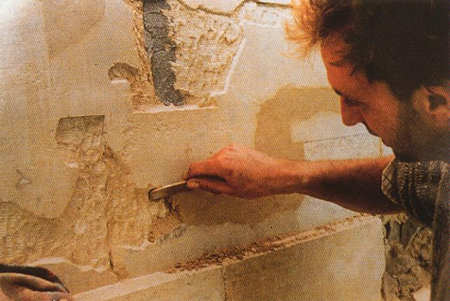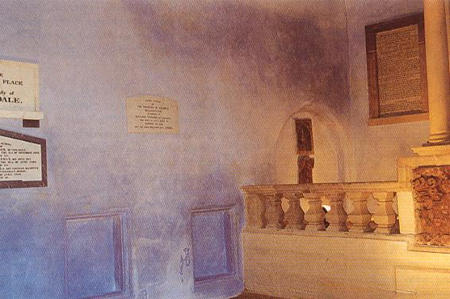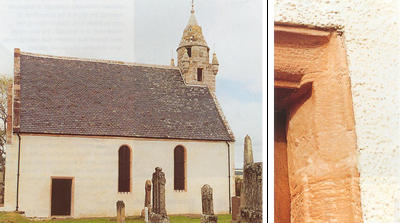Lime: The Basics
Jonathan Taylor
WHAT
IS IT?
At times the term 'lime' is used rather confusingly to refer to a variety
of products made from limestone and chalk (both forms of calcium carbonate).
In the context of building conservation, the term is most commonly applied
to types of binder used in plaster, limewash, render and mortar that are
made by burning limestone or chalk to make quicklime and then slaking
this with water.
 Mick Barnfields of St Blaise carrying out mortar repairs |
Mortar is the stuff between the bricks or blocks of stone in masonry walls
which closes the gaps and makes the structure wind-proof. It is usually
composed of washed sand and other aggregates, with a binder to protect it
from erosion by the wind and rain. In some areas of the country, coatings
of the same material as the mortar are commonly applied over the stone or
brick to form a coarse, exterior plaster known as render or, in Scotland,
harling. This is often finished with limewash (lime mixed with tallow or
linseed oil), coloured with natural earth pigments which produce delightfully
soft, uneven colours.
Prior to the introduction of cement in the early 19th century, the binder
used in mortar and render was almost invariably lime, and this material
continued to be used widely until the end of the century.
NON-HYDRAULIC
LIME
Lime is made by first burning chalk or limestone to form quick lime (calcium
oxide) and then slaking the quicklime with water (forming calcium hydroxide).
If no clay is present in the original limestone or chalk, the resulting
lime is said to be 'non-hydraulic'. This form stiffens and eventually hardens
by reacting with carbon dioxide which is present in rainwater (in the form
of a weak solution of carbonic acid) to form calcium carbonate once again;
a process known as carbonation.
 Wardlaw Mausoleum: Interior conservation work included lime plastering and limewashing |
LIME PUTTY
For conservation work, non-hydraulic lime is usually used in the saturated
form known as 'lime putty'. This is supplied to site covered by a thin film
of water in air tight tubs, to minimize the risk of carbonation. It is made
by slaking the lime with a slight excess of water. When matured (lime putty
continues to mature for months), the result is the purest form of non-hydraulic
lime, ideal for making fine plasterwork and limewash, but also widely used
for pointing masonry and making render, daub and other lime-based mortars.
DRY-SLAKED LIME
To construct towns and cities at the rate required in the late 18th century,
Gerard Lynch, the historic brickwork consultant, has convincingly argued
that most lime must have been made on site and used immediately, without
waiting for it to mature. Dry-slaking is ideal for this: lumps of fresh
quicklime are slaked with a limited amount of water and then immediately
covered over with damp sand; then, after screening to remove any remaining
particles of unslaked quicklime, the mixture of sand and lime is knocked
up with water ready for immediate use, although it was probably 'banked'
to allow the lime to mature for a few days first.
 Wardlaw Mausoleum: The external lime harling (or render) was repaired successfully by William Napier and The Scottish Lime Centre using a complex, or hybrid, mortar to match the original, and then limewashed |
BAG LIME
Most builders merchants supply a dry form of non-hydraulic lime which can
be used like lime putty if allowed to soak in water for a while. Known as
'dry-hydrated' lime or 'bag lime', it is generally considered to be inferior
to lime putty, not least because an unknown proportion will have reacted
with carbon dioxide by the time it reaches the site.
HYDRAULIC
LIME
If the limestone contains particles of clay, after burning at 950-1200°C
and slaking, the lime produced sets by reaction with water. Limestone containing
the lowest proportion of clay (less than 12 per cent) results in a feebly
hydraulic lime with properties close to non-hydraulic lime, which is relatively
weak, permeable and porous. Higher proportions result in successively stronger
and less permeable lime mortars. Because they react with water, hydraulic
limes are usually supplied to site as dry powder. However, they can also
be made by dry-slaking on site and may be knocked up with water and banked
on site for a few days.
Banking is not thought to harm the mortar despite the commencement of the
set, as the bonds formed during banking are reformed later, after the mortar
has been knocked up again. Indeed, the process may actually result in a
better set ultimately, as the lime is more mature.
POZZOLANIC ADDITIVES
The hydraulic set takes place due to complex chemical changes involving
the hydration of calcium silicates and aluminates in particular. A similar
effect can be achieved by adding pozzolanic additives to non-hydraulic lime
as these additives contain highly reactive silica and alumina. Pozzolanic
additives include some types of brick dust, fired china clay (such as metakaolin
and HTI/'high temperature insulation'), PFA/'pulverised fuel ash', volcanic
ash and pumice.
HYBRID MORTARS
Mixtures of hydraulic and non-hydraulic lime were used in the past to create
what English Heritage has termed 'hybrid' lime mortars (Historic Scotland
describes them as 'complex' mortars). However, the performance of a hybrid
mortar was called into question by English Heritage following a number of
spectacular failures, after which it banned the use of these mixtures on
grant-aided work. The results of a study by the Building Research Establishment
and English Heritage, which are now being prepared for publication, show
that the addition of a small amount of non-hydraulic lime (5-10 per cent)
improves workability but anything above this level significantly impairs
durability. Mixes containing 1:3:12 and 1:2:9 hydraulic lime:non-hydraulic
lime:sand actually performed less well than a standard 1:3 non-hydraulic
lime:sand mix in their tests.
AGGREGATES
Generally, mortars for conservation and repair work should include the same
range and types of aggregate particles as the original mortar, as well as
the same binder and any pozzolanic additives, unless any of these are actually
harmful. This is to ensure that the new mortar performs in the same manner
as the old and is similar in appearance. The original mix is best determined
by analysis. Several companies offer mortar analysis services - see The
Building Conservation Directory or the Directory pages of this
website for details. Common aggregates include local river sand and particles
of brick (which may not have any pozzolanic effect), stone and old mortar,
as well as extraneous material from the firing process in particular, such
as specs of coal dust. The choice of aggregate has a significant effect
on the performance and the appearance of lime mortar. In particular, any
aggregate used should be well washed and graded, free from sulphates (this
tends to rule out the addition of coal dust even if found in the original
mortar), clinker and alkalis such as sodium and potassium hydroxide. Other
factors which have a significant effect on performance include particle
size and shape. The correct specification of the mortar for pointing or
rendering old buildings is vital. Bear in mind that some proprietary mixes
may contain cement, and that a mortar which is too hard or too impervious
may cause extensive damage to historic masonry and other structures.
Further information
- The Scottish Lime Centre. For details of training programmes and other services offered by The Scottish Lime Centre Trust & Charlestown Workshops, please phone 01383 872722, E-mail info@scotlime.org, or visit their website www.scotlime.org
- Hybrid mortars. For details of English Heritage's research into hybrid mortars, please phone English Heritage's Conservation team on 020 7973 3073
.



